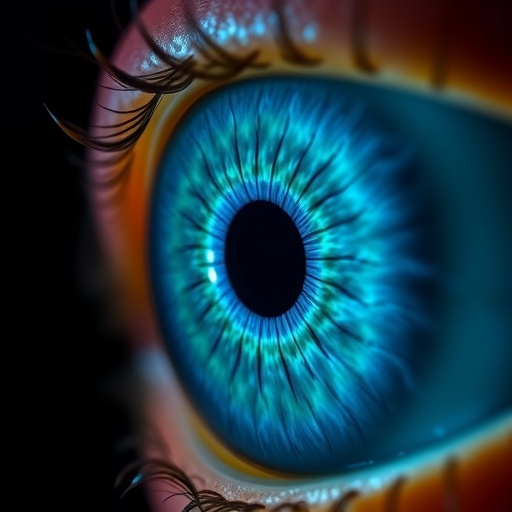
In an extraordinary leap forward for ophthalmic research and imaging technology, a team of scientists led by Alhaddad, Ghouali, Baudouin, and their colleagues has introduced a groundbreaking technique known as Transmission Interference Microscopy (TIM) to study the intricate anatomy of the anterior human eye. Published in Nature Communications in 2025, this pioneering work is set to revolutionize how clinicians and researchers visualize and understand the corneal microstructures, promising advancements in diagnosing and treating ocular diseases with unprecedented clarity and precision.
For decades, ophthalmologists have relied heavily on conventional imaging modalities such as optical coherence tomography (OCT), scanning electron microscopy, and confocal microscopy to investigate the fine structures of the eye. Each of these methods, while powerful, carries intrinsic limitations: from resolution constraints and image artifacts to invasive preparation requirements. TIM offers a transformative approach by harnessing the principles of transmission interference, enabling label-free, high-contrast imaging of transparent eye tissues in their native state without the need for stains or dyes.
The anterior segment of the human eye—comprising the cornea, iris, lens, and associated fluidics—is notoriously challenging to image due to its delicate and transparent nature. The corneal layers, including the epithelium, Bowman’s layer, stroma, Descemet’s membrane, and endothelium, possess subtle refractive index variations that are difficult to capture distinctly with traditional methods. The TIM technique exploits the interference patterns formed when coherent light traverses these microstructures, translating phase shifts into vivid contrast enhancements. This allows visualization of minute details such as collagen fibril architecture, cellular arrangements, and extracellular matrix composition in ways hitherto possible only through invasive histological sectioning.
.adsslot_9mfhC8NgeJ{width:728px !important;height:90px !important;}
@media(max-width:1199px){ .adsslot_9mfhC8NgeJ{width:468px !important;height:60px !important;}
}
@media(max-width:767px){ .adsslot_9mfhC8NgeJ{width:320px !important;height:50px !important;}
}
ADVERTISEMENT
The implications for clinical ophthalmology are profound. Early detection of corneal dystrophies, keratoconus, and other degenerative diseases often depends on identifying subtle morphological changes that are invisible to standard slit-lamp biomicroscopy or OCT. By providing a non-invasive window into the micro or even nanoscale structural integrity of the anterior eye, TIM equips clinicians with real-time diagnostic tools that could fundamentally alter patient care pathways. Moreover, longitudinal studies monitoring disease progression or therapeutic responses stand to gain critical insights through this new imaging modality.
What sets TIM apart from phase contrast or differential interference contrast microscopy is its quantitative capability. Unlike qualitative interpretation in traditional approaches, TIM generates precise interference maps that can be computationally analyzed to extract biophysical parameters such as tissue thickness, collagen density, and refractive index distribution. These metrics are indispensable for establishing normative databases, refining surgical planning for procedures like LASIK or corneal transplantation, and evaluating the biomechanical properties of corneal tissue under various physiological stresses.
The technical ingenuity of this research lies in the design of a transmission interferometric setup tailored for the anterior segment’s curved geometry and the dynamic aqueous environment. The team devised a stabilized coherent light source system combined with high-speed detectors and advanced image processing algorithms to mitigate motion artifacts due to blinking or micro-saccades, a major challenge in capturing reliable ocular data. Their approach seamlessly integrates with clinical workflow, requiring minimal patient discomfort and showing compatibility with in vivo imaging conditions.
Furthermore, TIM’s ability to visualize cellular level phenomena such as keratocyte activity, endothelial cell density, and nerve fiber distribution holds promise for neuro-ophthalmology and regenerative medicine. Understanding how these cells interact and respond under pathological states or therapeutic interventions could unlock new therapeutic targets. Given the eye’s status as an accessible window to systemic health, TIM might also pave pathways toward non-invasive monitoring of neurodegenerative diseases that manifest ocular biomarkers.
The visualizations produced by TIM are not only scientifically revealing but also aesthetically striking. By translating phase variations into detailed, vibrant images, this technique inspires a new appreciation for the complexity and beauty of ocular anatomy. Such vivid representations have the potential to engage the wider public and healthcare professionals alike, fostering greater awareness and enthusiasm for eye health and research innovations.
As the technology matures, integration with artificial intelligence (AI) and machine learning tools could expedite diagnosis by automating the detection of anomalies in TIM images. Pattern recognition models trained on large datasets could identify early pathological hallmarks invisible to the human eye, making TIM an indispensable component of future ophthalmic diagnostic suites. This synergy of advanced optics and computational prowess heralds a new era in personalized medicine tailored to ocular health.
The multi-disciplinary nature of this advancement—merging optics, biology, engineering, and clinical insights—exemplifies the collaborative spirit driving modern biomedical breakthroughs. It challenges existing paradigms and encourages a reevaluation of diagnostic protocols and research methodologies. Potentially, TIM might also be adapted for other transparent tissues beyond the eye, broadening its impact across biomedical fields.
In summary, the introduction of Transmission Interference Microscopy for imaging the anterior human eye represents a monumental stride in both optical instrumentation and clinical ophthalmology. Its ability to provide label-free, high-resolution, quantitative imaging in vivo addresses longstanding hurdles in the field, enhancing diagnostic accuracy and deepening scientific understanding of ocular microanatomy. Future work expanding its applications, refining its integration into clinical practice, and augmenting its analytical capabilities will undoubtedly propel this innovation from a laboratory milestone to a standard diagnostic tool worldwide.
Alhaddad and colleagues’ visionary research opens new horizons for the study and care of the human eye, laying a foundation for discoveries that could reshape ocular medicine for generations to come. As this technology gains traction, we can anticipate a cascade of insights into corneal diseases, neuro-ophthalmic conditions, and regenerative therapies that will elevate patient outcomes and fuel continuous scientific inquiry.
Subject of Research:
Transmission interference microscopy applied to the anterior segment of the human eye, focusing on advanced imaging of corneal microstructures.
Article Title:
Transmission interference microscopy of anterior human eye.
Article References:
Alhaddad, S., Ghouali, W., Baudouin, C. et al. Transmission interference microscopy of anterior human eye. Nat Commun 16, 7838 (2025). https://doi.org/10.1038/s41467-025-62718-6
Image Credits: AI Generated
Tags: anterior human eye imagingconfocal microscopy applicationscorneal anatomy studycorneal microstructures analysishigh-contrast imaging methodsinnovative ophthalmology technologieslabel-free imaging techniquesocular disease diagnosisophthalmic research advancementsoptical coherence tomography limitationsTransmission Interference Microscopytransparent tissue visualization





